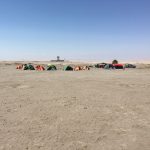Stranded in Tacna after the police shut down our Hawapi camp. Locals reported signs of a foreign invasion to the authorities, noting odd structures and suspicious demarcations; the press took it even further and the police got to work. All passports, data and footage were seized and temporarily confiscated. But the Peruvian police were always kind and after a long day detained in suspense in their desert outpost, we got a night ride through the desert all the way to our hostel in Tacna.

We pitched our tents on the Peruvian side of the disputed border. The disputed border is a triangle of land at the coast. Two sides on land converge at landmark Hito 1: one side traces the geographic parallel straight to the coast at the maritime border limit, the other connects the Hito 1 point to Punto Concordia, the formerly established border point, 10 kilometers north of the River Lluta. Two of the three vertices are situated on the coastline and the third only 264m inland, at Hito 1. The area of the triangle is 3.761 hectares. The area inside the limits of the triangle is nothing but sand and sparse vegetation, having been successfully cleared of its landmines. It is now an impenetrable, empty field, guarded on one side by the Peruvian police, and one side by the Chilean police, and the other by the uncompromising Pacific Ocean (although that stretch of water is unilaterally claimed by Chile). Our camp was right beyond the triangle’s Peruvian boundary, on a flat field of sand protected by soft dunes and wild sugarcane groves, under the gaze of the police watchtowers.

The terrestrial triangle has two sides earth.
While one side, sea, is made and unmade by the tide.
The triangle is by nature unfulfilled.
Inside the triangle is shrubby desert, devoid of human life.
Its nine acres can never be claimed or touched.
The rival soldiers that patrol its two desert borders guard its emptiness.
Dutifully protect its eternal ambiguity.
Zealously preserve its unearthliness.
The terrestrial triangle is a metaphysical triangle.
We were pondering the incongruity of the geometry, wondering how to reconcile the bilateral standoff and the triangular forcefield.
We took a long walk down the beach to Santa Rosa.
We bought a couple of bottles of cold beer and sit in the shade of the shuttered up Puesto de Salud. I took out my notebook as Iván unraveled a sticker he found in a pile of beach trash.
A bumper sticker of the Peruvian National Police’s coat of arms.
An oval frame with two crossed swords, dividing it diagonally into four quarters. The intersection of the two swords is covered by the shield, itself divided into three sections, two smaller ones on the upper half and one larger one on the lower half. Each of the three sections contains a symbolic figure: a llama, a tree, and a cornucopia spilling gold coins; the animal, vegetal, and mineral wealth of the land.
Below the shield, three words adorn a floating scroll, the motto: DIOS PATRIA LEY
The words do not refer to the three symbols, but to another trinity.
PATRIA pulsates in the center, prominent, in a high-contrast black-on-white text.
Exuberant.
While DIOS and LEY wave from their lateral positions, the supporters, loyal auxiliaries, in a low-contrast black-on-red text.
Subdued, partially eclipsed.
LEY on the right flank.
DIOS on the left.
Swords in hand, they parry.
As the cornucopia of gold coins pours down onto PATRIA
In a triangle all sides meet each other.
DIOS falls into place between the diminutive LEY and the effusive PATRIA.
DIOS fulfills the triangle.
At that moment, Iván plucked from the stony ground a small triangle of broken glass.
A scalene triangle whose proportions recall the proportions of terrestrial triangle.
Just as we were trying to situate DIOS.
This little triangle signaled to us.
That it had been there all along.
The pure triangle.
Perfect asymmetry.
Intact and impenetrable.
All sides meet each other in a triangle.
DIOS PATRIA LEY
LEY DIOS PATRIA
PATRIA DIOS LEY
LEY PATRIA DIOS
DIOS LEY PATRIA
PATRIA DIOS LEY
The 16 participants are divided into two camps.
The red and the white.
Each group occupies two sides of a square arena.
Four and four.
An invisible diagonal boundary crosses the square.
Each side meets, one by one, in the center with its diametrical opponents.
To perform a mutual gesture.
First dance is PATRIA.
Crossing swords.
Two by two.
Then all reel together in pairs.
Crossing swords.
Second dance is LEY.
Counterbalance.
Two by two.
Then all reel together in pairs.
Counterbalance.
Then all leave the arena.
DIOS
Libation.
Coca-leaf tea.
Todos juntos.
